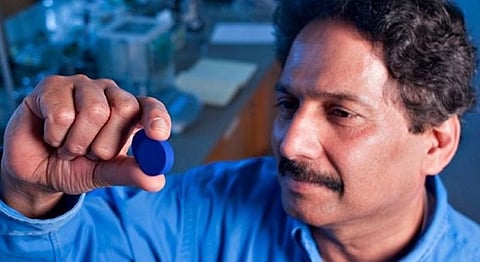
- HOMEGROWN WORLD
- #HGCREATORS
- #HGEXPLORE
- #HGVOICES
- #HGSHOP
- CAREERS
- ABOUT US
- CONTACT US

An experiment to find a durable pigment led to an accident. In 2009, when the accident occurred, a new shade of a colour was invented which would grip both science and art nerds. “We were trying to find a material with novel magnetic properties for electronics applications, but it didn’t work. I didn’t think it would have a special color. I expected it to be brown or black,” said Mas Subramanian, who grew up in Madras (now called Chennai), India, and received his Ph.D. at the Indian Institute of Technology. “But when I saw what he had, I knew this was something unusual,” he said in an interview on Oregon State University website, where he conducted his research. “One day a graduate student who is working in the project was taking samples out of a very hot furnace while I was walking by and it was blue, a very beautiful blue, I realised immediately that something amazing had happened,” he said in an interview with the Sydney Morning Herald.
YInMn Blue is as bright and gripping as any blue we see, what makes it special is that it is environmentally viable and better than its siblings in the heat resistant tests. It is touted as one of the near-perfect shades of blue and the team was not even working with a goal to find it, it just revealed itself. In the same interview at Oregon University, the leader of the team that set out with this research, Subramanian said, “The new blue is stable and relatively non-toxic. Produced at temperatures in excess of 2,200 degrees Fahrenheit, it reflects infrared energy and may thus help to cool buildings and reduce air conditioning costs. And it can be “tuned, to produce a range of shades from sky blue to nearly black.”
The scientists mixed black manganese oxide with a variety of chemicals and the pigment received its name from its elemental makeup which includes Yttrium, Indium and Manganese. Forbes magazine reported that ‘currently we do not have pigments to match every color in the rainbow, and some colors have always been notoriously difficult to find in nature, particularly those blue and indigo colors; indeed, indigo was originally found in small quantities in India, extracted from the plant Indigofera tinctoria, and exported in small quantities for vast sums of money. These days, blue dyes are reasonably commonplace, but are prone to rapidly losing their vibrancy,’ it said. The last durable blue pigment discovered was Cobalt blue (Co-blue) in 1802 and is said to be carcinogenic. Colours like Prussian blue and Aquamarine blue turn out to be toxic and expensive, the new colour could prove to be sustainable in more ways than one. The new pigment has proven to be durable against oil and water as well and promises to not fade into the dark alleys with its elemental properties.
A report by Huffington Post stated that the pigment could also be used in roofing materials. Since YInMn blue reflects about 40 percent of infrared energy, it could keep buildings cooler. So it could reduce air conditioning costs. ‘Since publishing the discovery in the Journal of the American Chemical Society, Subramanian has worked with artists (such as Portland-based Rebecca Shapiro), paint manufacturers, energy conservation companies and the German chemical firm Merck KGaA, which makes pigments for coatings (automobiles, aircraft), plastics, inks and cosmetics. Even the U.S. Navy has expressed interest since ships painted with the heat-reflecting pigment may be less visible to detection through infrared imaging,” said the Oregon report.
The Huffington Post reported that Subramanian shared this pigment with artists to have their very own experiments with the new colour and OSU visual artists Maddy Corbin and Rebbeca Shapiro have used it in their work.
[caption id=”attachment_59542” align=”aligncenter” width=”800”] Artist Maddy Corbin uses the YInMn Blue to represent the Memorial Union Building of Oregon State University. Image Credit: Huffington Post[/caption]
“Ever since the early Egyptians developed some of the first blue pigments, the pigment industry has been struggling to address problems with safety, toxicity and durability,” said Subramanian in statement released by OSU. Existing blue pigments include ultramarine, made from ground lapis lazuli, and toxic alternatives such as cobalt blue and Prussian blue, making OSU’s discovery a major breakthrough, and the first new blue in over 200 years, reported the artnet.com.
YInMn, Subramanian added, is “more durable, safe and fairly easy to produce… it also appears to be a new candidate for energy efficiency.”
He told artnet that he’s perhaps most proud of YInMn’s inclusion in the Forbes Pigment Collection at the Harvard Art Museums, which serves as world history of color, with some pigments dating back to the Middle Ages. He has already worked on creating various viable pigments of blues, greens, yellows and oranges and wishes to a find a good red colour in the future.
Now we know that humanity has not explored all the colours in the rainbow spectrum and that this royal pigment that has a bright and colourful future.
Feature Image Courtesy: Karl Maasdam/Oregon State University
Words: Preksha Malu
